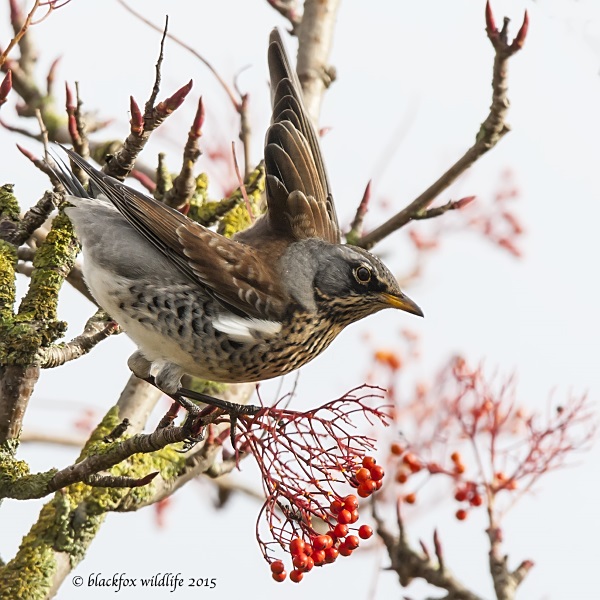Site menu:

December 2015 Newsletter
Species Spotlight - Twite.
Colour Ring Report.Wirral Wader Festival.
Birkenhead Docks Birding Blog.
November Bird News.
Forthcoming Events.
Latest Newsletter.
Species Spotlight - Twite

North Wales Twite Project
The project has for some years been
colour ringing Twite in the
Snowdonia breeding grounds and at the wintering grounds on the Dee
estuary and various other localities along the North Wales coast.
The results are beginning to indicate that our small relic breeding
population (in Nant
Ffrancon, Snowdonia) migrate eastwards during the autumn
and winter on the
Dee estuary. Larger numbers of birds join them, from the
Pennine
breeding population and further afield. Some of the Pennine birds
continue east and winter on the Norfolk coast. In the second year of
the project it was suspected that a Nant Ffrancon bird has been seen in
the company of some Pennines birds at Titchwell, however the ring
combination seen was not sufficient for a 100% identification. This
last winter (2014/15) a bird ringed in Nant Ffrancon in April was seen
in a Twite
flock on the Norfolk coast.
In 2010 a small flock of Twite were present on Pensarn beach one of
which had a BTO metal ring. This flock was caught and the ringed bird
was found to be from near Lochinver in north-western Scotland. In
December 2014 another one of this flock was recaught at Askham,
Cumbria. The small flock which appeared at Cemlyn last autumn
also contained a ringed bird. When she was eventually caught she was
found to be from the 15 miles south of the original Pensarn Scottish
bird.
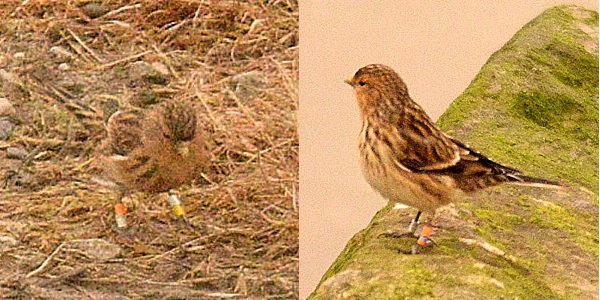
For the past two winters we have been
very lucky to have Richard
Beckett join the Twite team, and Richard has spent many hours recording
ring combinations and the comings and goings of the Dee estuary
birds. This winter a reasonable number of Twite have been
feeding regularly at Deeside Naturalist Society reserve at Connah's
Quay, and with their
continued permission a further 68 have been colour ringed. Also caught
have been a number of birds originally ringed at the Mull of Kintyre.
The Mull of Kintyre have a small breeding population but also has a
marked passage of autumn birds passing south and reasonable numbers
have been ringed there.
We are initially proposing that the coastal wintering birds
here in North Wales may well be birds from the north west of Scotland,
with our Welsh birds from Snowdonia venturing eastwards and mixing with
Pennine birds on the Dee estuary, some of which will continue eastwards
with
their new mates.
Due to Richards’s diligence last year we knew when the Dee estuary
birds
began their spring dispersal and a few weeks later the first of the
Nant Ffrancon birds were back in the Ogwen valley. From Richards’s
recent observations the flock at Connah's Quay has now begun to
disperse (April 2015).
Over the next few weeks the critically low Welsh breeding population
will be making their way along the North Wales coast back to Ogwen. Can
I ask all North Wales Birders to be aware of this and keep an eye and
an ear open for them on passage? We have about two and a half weeks and
it would be very interesting if we could plot some of their traditional
staging points along the coast.
Thanks and happy hunting.
Please report any sightings to kelvin.jones@bto.org.
The North Wales Twite
Project is a collaborative project between,
Kelvin Jones, Ian Spence, Richard Beckett, RSPB Cymru, BTO Cymru,
National Trust, Snowdonia National Park, Deeside Naturalists Society,
North Wales Wildlife Trust, and Flintshire Council.
This article first published in April 2015 on the BTO Cymru Blog (btocymru.blogspot.co.uk) and reproduced here with kind permission of the author.
Kelvin Jones
Twite - Status on the Dee
Estuary
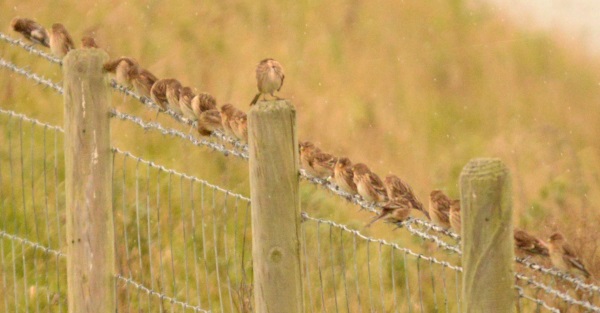
In the UK Twite (Carduelis flavrosris) are on the Red-list for Birds of Conservation Concern because of a long-term decline, particularly during the 20th century. However, as is often the case with birds, the picture is complex and that is one of the reasons why various colour ringing schemes have been set up to try and gain a better understanding of what is happening, one of these schemes is run by BTO Cyrmu and includes birds ringed on the Dee Estuary. The recent BTO Atlas 2007-11 showed a 19% contraction in breeding range since the 1968-72 Breeding Atlas, perhaps not such a dramatic reduction over 40 years as some people had feared, whereas there was an unexpected increase of 19% for the wintering area since the 1981-84 Winter Atlas. One problem is that breeding Twite are very difficult to survey with birds nesting in loose colonies and showing very little territorial behaviour in relation to the nest site. A study of the South Pennine area in the 1990s, where it's thought there has been a sharp decline, showed a marked reduction in range but nesting density had almost doubled.
On the west coast of England and Wales birds winter in flocks usually of 50 to 100 birds at various locations in Cumbria, Lancashire and the Welsh coast of the Dee estuary, with a few small flocks occasionally reported along the North Wales coast as far as Anglesey. On the Dee estuary nearly all birds are recorded in the area which includes the Connah's Quay Nature Reserve, Oakenholt Marsh and around Flint Castle. They also visit the salt marsh on the far side of the River Dee channel which is seldom visited by birders so many probably go unrecorded.
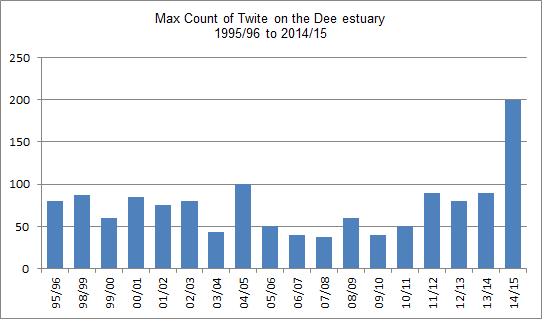
The
graph shows max counts for the past 20 years on the Dee estuary, all of
which have been either at Connah's Quay Nature Reserve or around Flint
Castle. Apart from a dip in the mid-2000s numbers have held pretty
steady at the 50 to 100 level. That is until last winter (2014/15) when
there were no less than nine counts of 100 or more, all at Connah's
Quay, peaking with at least 200 on January 21st. It is unclear why
there has been a sudden increase but some habitat creation in the form
of permanent drinking pools has helped and may well have attracted the
birds which normally spend the winter across the River Dee on the
marshes. We also heard that there were smaller numbers than normal at
Southport and Heysham so it's possible birds travelled a bit further
south than usual. According to reports on Bird Guides (not necessarily
a reliable measure of Twite flocks) this was the biggest wintering
flock outside Scotland that winter, although I note a flock of 263 at
Knott End, Lancashire, in November 2014 which didn't get put on Bird
Guides. But whatever the size of flocks elsewhere there's no doubt that
this part of the Dee Estuary is one of the most important wintering
sites in the country for this species.

Twite do occur elsewhere on the estuary and
nearby coasts but they are irregular visitors away from their
stronghold. Last winter we had 16 reported both at Gronant and Red
Rocks in November, but only on single days. The longest staying birds
in recent years were a flock of 13 which spent from December 2008 to
February 2009 on Thurstaston beach, we also sometimes get larger flocks
reported from Burton and Parkgate which are probably visitors from
Connah's Quay.
This winter looks like another good one for them and numbers had already reached over 50 by November 27th. If you want to see them the largest flocks are at Connah's Quay but remember they are being studied here on a daily basis so be VERY careful not to disturb them, and if you see other birders there take their advice about the best place to go. Remember the Connah's Quay Reserve is members only. The other regular site is around Flint Castle and they are often to be seen on the nearby marsh where photographs can be taken, although I wouldn't advise going out onto the marsh itself unless you want to be stuck in thick estaurine mud!
References/Sources of Information
1. Birds of Conservation Concern 3, BTO/RSPB.
2. Bird Atlas 2007-11, BTO, 2013.
3. Rowena H.W. Langston et al., Status of breeding Twite in the UK, Bird Study, 53:1, 55-56 2006.
4. Peter Middleton, The South Pennine Twite population, British Birds 100, Feb 2007.
5. BTO Bird Ringing Blog, entry for 7th October 2014 "Looking out for Twite".
6. Bird Guides www.birdguides.com.
7. All those who have sent Twite records to me for inclusion in www.deestuary.co.uk, with particular thanks to Richard Beckett.
8. Clwyd Bird Reports/North East Wales Bird Reports 1995 to 2013.
Richard Smith.
Top of PageColour Ring/Wing Tag
Report
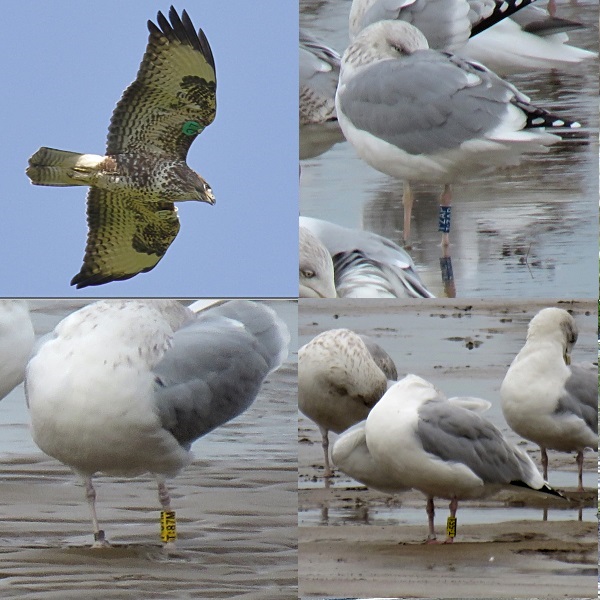
Large raptors tend to be wing-tagged rather than colour-ringed, and a
juvenile Buzzard was recorded at the end of September. Not a very
exciting record but the dispersal of juvenile Buzzards is a very
interesting area of research and their dispersal no doubt has an impact
on how they are continuing to spread. Another one was in the Leasowe
Lighthouse area in the autumn but too distant to read the wing tags.
We have been completely frustrated in our attempts to log any colour ringed small waders over the past few months, and even most of the Black-tailed Godwits have moved on. To make up for that there have been large numbers of gulls at Hoylake, mainly Herring Gulls, and we describe the history of the three photogrpahed above.
Common Buzzard
LC green, LC grey wing-tagged.Tagged as a nestling at Thornton Hough, Wirral, on July 1st 2015.
Recorded at Thornton Hough on September 30th 2015.
Herring Gulls
T.ZAP white on blue ring.Ringed as a chick at Zeebrugge, Belgium on July 15th, 2011.
Recorded at Hoylake Shore on November 26th, 2015.
After it was ringed it moved SW to Nieuwpoort (near Ostend) where it was seen in August then moved inland to Blaringhem in France (west of Lens) where it remained the rest of that winter (2011/12). September 2012 saw it at Pas-de-Calais before being sighted back in Blaringhem in December 2012. The only other record was back at Pas-de-Calais in May 2013.
T:87M black on yellow ring.
Adult male ringed in Aberdeen on July 25th 2013.
Recorded at Hoylake Shore on October 28th 2015.
The only other record was also at Hoylake Shore on September 21st 2013.
T:551 black on yellow ring.
Adult male ringed at Medicine Well, Montrose, on May 24th 2012.
Recorded on Hoylake Shore on November 14th 2015.
Recorded at Moore Nature Reserve by Mersey estuary in January 2013 and on Crosby Beach in November 2013 before moving to Richmond Bank in the Mersey Estuary in February 2014. It was at New Brighton in August 2015.
Black-tailed Godwit
LW-WN ringed as a chick in southern Iceland on June 19th 2015.Recorded at Gilroy Nature Park on October 28th 2015.
First record after ringing was at Traigh golf course, Morar, Scotland, on August 9th before moving on to the RSPB Reserve at Conwy where it was on August 12th.
Richard Smith and Matt Thomas.
Colour-ringed birds were also recorded by Charles Farnell, John Jakeman and Steve Hinde.
Wirral Wader Festival

The weather did it's best to sabotage the Wirral Wader Festival on November 14th and 15th but despite that it was a big success. I was at Hoylake for the High Tide Birdwatches on both days and was surprised just how many birds there were given the distinct lack of them a few days earlier. For me the most spectacular sight was the huge number of gulls. My estimate was 8,000 Herring Gulls on Saturday morning and when a Great Skua flew over (unseen by me!) the whole lot flew up making for a fantastic display. We also had a Mediterranean Gull and a good selection of waders, but the highlight was a fly past by a Long-tailed Duck.
There was a steady flow of visitors to the Thurstaston Visitor Centre looking at the stalls and attending the various talks. I think I was the RSPB stall's first visitor and I got them off to a good start by buying an expensive tripod! As expected, Alan and Ruth Davies of the Biggest Twitch were a big draw; as well as chatting to people they gave a talk and led two low tide birdwatches on Thurstaston Shore.
Read more about the festival here:
http://www.waderquest.org/2015/11/wirral-wader-festival-survives-storm.html
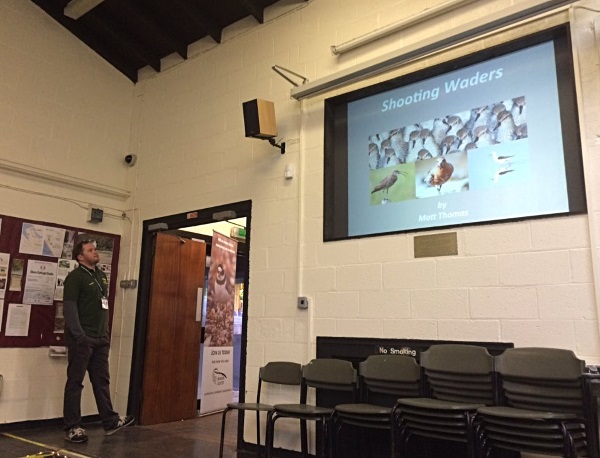
Birkenhead Docks Birding Blog
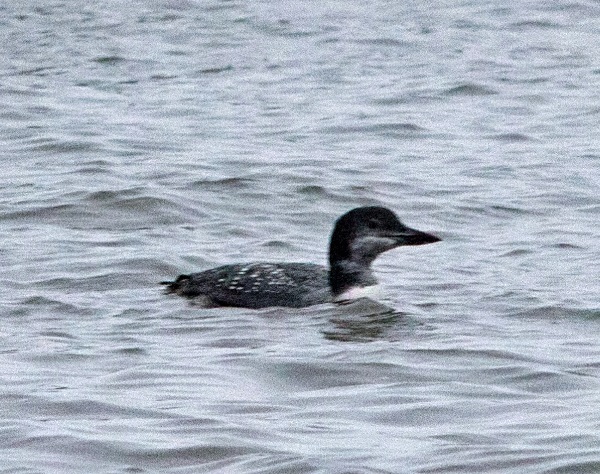
Just outside the area covered by deeestuary.co.uk are Birkenhead Docks, given it's industrial location it is a surprisingly good birding site. The docks are little used so the birds are rarely disturbed and they can have a good selection of water birds during the winter including the occasional rarity such as the Great Northern Diver above. This summer they were also home to Cheshire and Wirral's only Common Tern colony with about 20 pairs.
To see and hear all about what is
happening at Birkenhead Docks read the recently set up Birkenhead
Docks Birding Blog,
run by local birder Elliot Monteith.
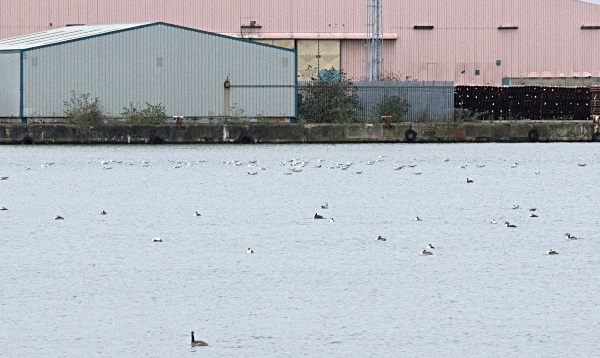
Top of Page
November Bird News
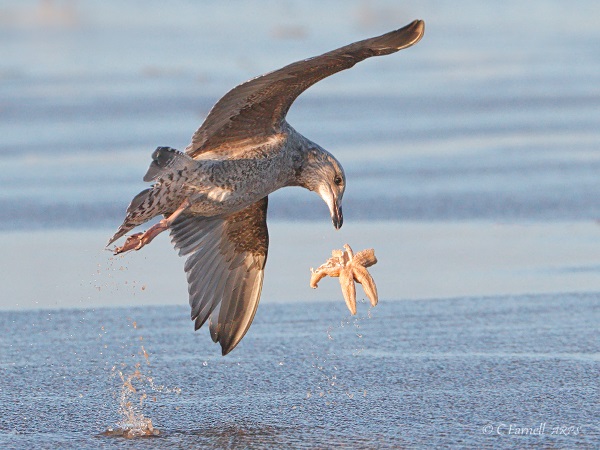
We did think it was going to be a Leach's Petrel free year but the gales arrived in the end and between the 13th and 20th we had 27 go past including eight off Leasowe Gunsite on the 20th. This was after prolonged south-west gales which blew them up from their wintering grounds out in the Atlantic and into the Irish Sea, a change of wind direction to West then pushed them past our coast. The gales also blew in the skuas with good numbers of Great Skuas in particular, five were off Hilbre on 14th and 16th and nine there on 18th. There were three records of Pomarine Skua including one over Burton Marsh on the 21st which was mobbed by a Marsh Harrier. An Arctic Skua was seen on the 17th and a Long-tailed Skua on the 19th.
A day after strong winds often brings in large numbers of gulls to north Wirral presumably attracted by a wreck of shell fish and other washed up food such as the starfish above. On the 14th there were 8,000 Herring Gulls at Hoylake but on the 22nd Hilbre Bird Observatory estimated a remarkable 20,000 on East Hoyle Bank. There were at least a total of 360 Kittiwakes counted from Hilbre during the strong winds of the 16th, a very high number for this species.
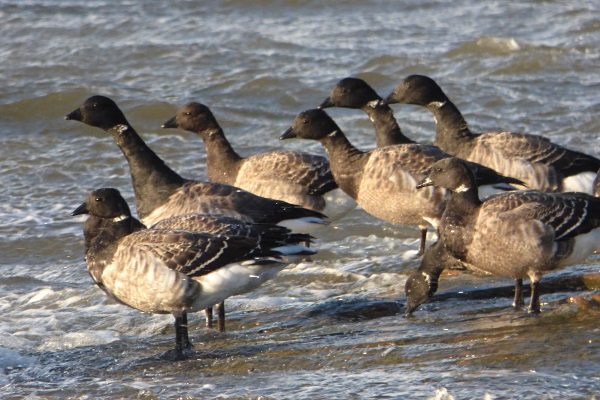
Brent Geese peaked at 144 off West Kirby on the 14th, although they have been difficult to count in the bad weather. There was a reserve record of 8,000 Teal at Burton Mere Welands on the 8th. A few years ago one or two Smew were regular at Inner Marsh Farm but these days are are somewhat of a vagrant so it was good to have one on the Rifle Range Pool in the inner marshes, unforunately it only stayed a day. Two Long-tailed Duck were off Hoylake and Red Rocks on the 14th and 15th.
This Red-throated Diver (below) arrived on West Kirby Marine Lake on the 25th and stayed for the rest of the month and a Great Northern Diver was off the north end of Hilbre on several dates through the month.
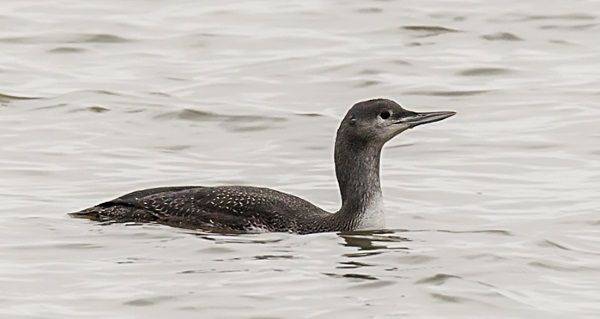
It continues to be a good winter for Short-eared Owls and off Denhall Quay we had five on the 1st and six on the 3rd and 22nd. They also turned up inland including two in a field by Hilbre School, West Kirby. It was a good month for Marsh Harriers with a max count of four, seen together, at Burton Mere Wetlands on the 9th. There were plenty reports of Hen Harriers, all ring-tails, with a max count of four at Denhall Quay on the 4th.
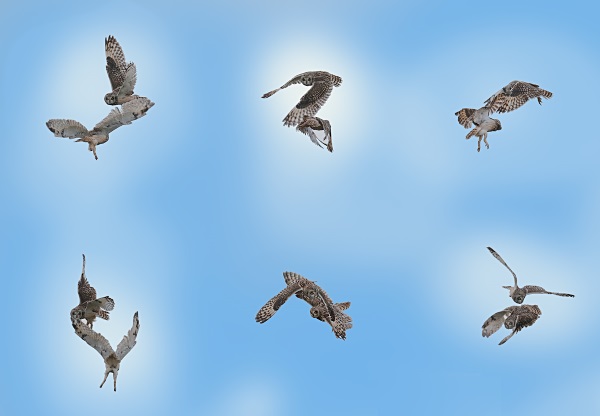
Mild temperatures and strong winds meant wader numbers were generally low with highlights of 10,000 Dunlin at West Kirby on the 1st, 3,000 Black-tailed Godwits at Connah's Quay on the 12th with 2,300 at Burton Mere Wetlands the next day. 14 Purple Sandpiper at Hilbre was a good count and there were at least six on the pontoon at New Brighton Marine Lake by the end of the month.
Richard Smith.
What to expect in December
Exciting birds can certainly be brought in by gales but personally I would much rather have crisp, sunny and windless days in which to do my birdwatching in. As a reminder of what that can be like have a look at the December 2010 newsletter. This is the sort of weather where you can count thousands of birds on the flat calm sea - Common, Velvet and (maybe) Surf Scoters, Great Crested Grebes, Red-throated Divers, Long-tailed Ducks and Scaup. Freezing conditions will also result in a big increase in waders, particularly Knot when spectacular flocks of up to 40,000 may be seen.
Whatever the weather we can expect to see Hen Harriers and Marsh Harriers on the marshes, and still weather would certainly bring the Short-eared Owls out with Denhall Quay probably the best spot to see these, we could get into double figures.
If we did get the wished for cold weather it will be interesting to see just how many Pink-footed Geese we see on the marshes, earlier this year the total reached over 6,000. Brent Geese will also increase through the month, last winter they peaked in December with 262.
Top of Page
Forthcoming Events
December Highest Spring Tides (Liverpool)
Also
see Tides
page.
26th December, 11.29hrs (GMT), 9.5m.
27th December, 12.11hrs (GMT), 9.5m.
Forthcoming Events
Organised by the Wirral
Ranger Service , Flintshire
Countryside Service and the
RSPB (Dee Estuary):
All these events and walks have bird interest, even those not
advertised specifically for birdwatching. No need to book for these
events unless specified - please check below.
Also see 2015 Events Diary.
1 pm - dusk
Price: Free
Most people have never seen a hen harrier, but once seen it is rarely forgotten. In support of the RSPB's Skydancer project, we are pleased to bring you a series of events to showcase these enigmatic birds of prey which use the marshes of the Dee Estuary as their home for the winter months.
The name "Skydancer" comes from the aerobatic displays that the male birds perform in their courtship ritual on the moors in the spring. Sadly, this has become an increasingly rare sight and they are close to becoming extinct as a breeding bird in England.
This could be the last chance to see Skydancers on the Dee, so come along to Parkgate to find out more about the hen harrier story and what you can do to help save them before it's too late. Look for the RSPB marquee along the main promenade at Parkgate, where friendly staff and volunteers will be on hand with telescopes and binoculars to show you these beautiful, agile birds hunting over the marsh, and coming in to roost there at dusk. Plenty of family activities and other RSPB information will be available.
Car parking is limited on Parkgate promenade, but there is free public parking at the Old Baths car park (CH64 6RN) at the north end of The Parade, and the Wirral Country Park car park on Station Road (CH64 6QJ). There are public toilets at Mostyn Square in the middle of The Parade, and a number of pubs and cafes for refreshments. Wrap up warm, and prepare to be patient as the harriers have a large area of marsh to roam!
For more information on the RSPB's Skydancer project, visit
http://www.rspb.org.uk/skydancer/
